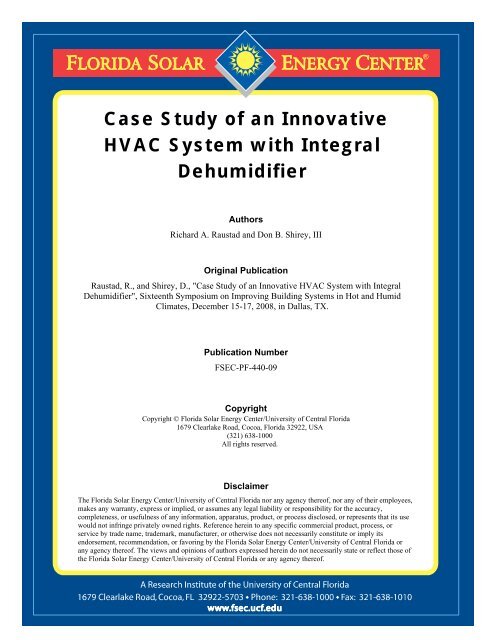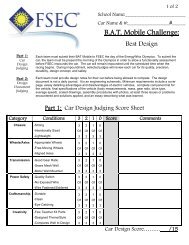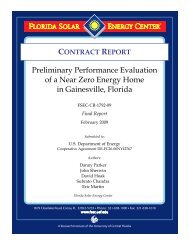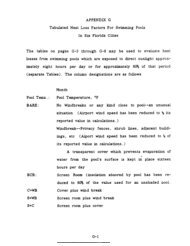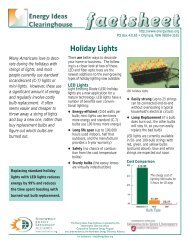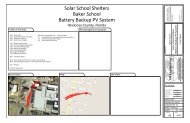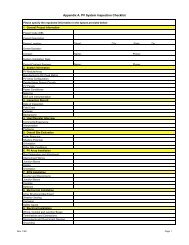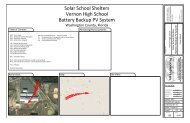Case Study of an Innovative HVAC System with Integral Dehumidifier
Case Study of an Innovative HVAC System with Integral Dehumidifier
Case Study of an Innovative HVAC System with Integral Dehumidifier
Create successful ePaper yourself
Turn your PDF publications into a flip-book with our unique Google optimized e-Paper software.
<strong>Case</strong> <strong>Study</strong> <strong>of</strong> <strong>an</strong> <strong>Innovative</strong><br />
<strong>HVAC</strong> <strong>System</strong> <strong>with</strong> <strong>Integral</strong><br />
<strong>Dehumidifier</strong><br />
Authors<br />
Richard A. Raustad <strong>an</strong>d Don B. Shirey, III<br />
Original Publication<br />
Raustad, R., <strong>an</strong>d Shirey, D., "<strong>Case</strong> <strong>Study</strong> <strong>of</strong> <strong>an</strong> <strong>Innovative</strong> <strong>HVAC</strong> <strong>System</strong> <strong>with</strong> <strong>Integral</strong><br />
<strong>Dehumidifier</strong>", Sixteenth Symposium on Improving Building <strong>System</strong>s in Hot <strong>an</strong>d Humid<br />
Climates, December 15-17, 2008, in Dallas, TX.<br />
Publication Number<br />
FSEC-PF-440-09<br />
Copyright<br />
Copyright © Florida Solar Energy Center/University <strong>of</strong> Central Florida<br />
1679 Clearlake Road, Cocoa, Florida 32922, USA<br />
(321) 638-1000<br />
All rights reserved.<br />
Disclaimer<br />
The Florida Solar Energy Center/University <strong>of</strong> Central Florida nor <strong>an</strong>y agency there<strong>of</strong>, nor <strong>an</strong>y <strong>of</strong> their employees,<br />
makes <strong>an</strong>y warr<strong>an</strong>ty, express or implied, or assumes <strong>an</strong>y legal liability or responsibility for the accuracy,<br />
completeness, or usefulness <strong>of</strong> <strong>an</strong>y information, apparatus, product, or process disclosed, or represents that its use<br />
would not infringe privately owned rights. Reference herein to <strong>an</strong>y specific commercial product, process, or<br />
service by trade name, trademark, m<strong>an</strong>ufacturer, or otherwise does not necessarily constitute or imply its<br />
endorsement, recommendation, or favoring by the Florida Solar Energy Center/University <strong>of</strong> Central Florida or<br />
<strong>an</strong>y agency there<strong>of</strong>. The views <strong>an</strong>d opinions <strong>of</strong> authors expressed herein do not necessarily state or reflect those <strong>of</strong><br />
the Florida Solar Energy Center/University <strong>of</strong> Central Florida or <strong>an</strong>y agency there<strong>of</strong>.
<strong>Case</strong> <strong>Study</strong> <strong>of</strong> <strong>an</strong> <strong>Innovative</strong> <strong>HVAC</strong> <strong>System</strong> <strong>with</strong> <strong>Integral</strong> <strong>Dehumidifier</strong><br />
Richard A. Raustad Don B. Shirey, III<br />
Senior Research Engineer Program M<strong>an</strong>ager<br />
Florida Solar Energy Center<br />
Cocoa, Florida<br />
ABSTRACT<br />
In most applications, heating, ventilating, <strong>an</strong>d<br />
air conditioning (<strong>HVAC</strong>) equipment is<br />
controlled to maintain <strong>an</strong> indoor dry-bulb set<br />
point temperature. Moisture removal by the<br />
<strong>HVAC</strong> system is considered to be <strong>an</strong> operational<br />
byproduct. During summer months, the<br />
operation <strong>of</strong> the <strong>HVAC</strong> system is usually<br />
sufficient to meet both the sensible <strong>an</strong>d latent<br />
cooling loads. However, during other times <strong>of</strong><br />
the year when sensible loads are reduced, the<br />
moisture load c<strong>an</strong> be signific<strong>an</strong>tly higher th<strong>an</strong> the<br />
available moisture removal capacity <strong>of</strong> the airconditioning<br />
system. This c<strong>an</strong> lead to elevated<br />
indoor relative humidity levels <strong>an</strong>d <strong>an</strong><br />
uncomfortable indoor environment.<br />
In m<strong>an</strong>y cases, designers, engineers <strong>an</strong>d<br />
building occup<strong>an</strong>ts combat high indoor relative<br />
humidity <strong>an</strong>d associated comfort problems <strong>with</strong><br />
the use <strong>of</strong> additional dehumidification equipment<br />
for both commercial <strong>an</strong>d residential applications.<br />
The use <strong>of</strong> extra dehumidification equipment c<strong>an</strong><br />
be expensive in terms <strong>of</strong> first cost <strong>an</strong>d <strong>an</strong>nual<br />
operating costs. First costs associated <strong>with</strong> this<br />
type <strong>of</strong> equipment may include additional<br />
electrical circuits, condensate drainage, <strong>an</strong>d<br />
additional air distribution systems. The loss <strong>of</strong><br />
usable floor area, localized noise, <strong>an</strong>d zonal “hotspots”<br />
c<strong>an</strong> also be considered a cost penalty.<br />
As <strong>an</strong> alternative to using separate equipment<br />
for meeting both the sensible <strong>an</strong>d latent<br />
components <strong>of</strong> a building’s cooling load, <strong>of</strong>f-theshelf<br />
products were used to construct a selfcontained<br />
air h<strong>an</strong>dler. The air h<strong>an</strong>dler is<br />
controlled using a low-cost thermostat <strong>an</strong>d<br />
humidistat. The dehumidification element <strong>of</strong> the<br />
system is completely independent from the air<br />
conditioner <strong>an</strong>d works nearly the same as<br />
conventional dehumidification equipment. At<br />
times, both the dehumidification equipment <strong>an</strong>d<br />
the air conditioner operate in unison when the<br />
need arises. The use <strong>of</strong> dehumidification<br />
equipment integrated <strong>with</strong> a conventional AC<br />
system provides a unique solution for moisture<br />
control applications.<br />
This paper describes the development <strong>an</strong>d<br />
testing <strong>of</strong> this integrated equipment. Although<br />
this technology is not new, the integration <strong>of</strong> a<br />
dehumidification system <strong>with</strong> a st<strong>an</strong>dard air<br />
conditioner is <strong>an</strong> innovative strategy that c<strong>an</strong> be<br />
used to address moisture control in buildings.<br />
This new <strong>HVAC</strong> configuration would provide a<br />
low-cost solution for building owners <strong>an</strong>d a more<br />
comfortable indoor environment for building<br />
occup<strong>an</strong>ts.<br />
KEYWORDS<br />
Humidity <strong>an</strong>d Comfort, Moisture Removal,<br />
Impact <strong>of</strong> St<strong>an</strong>dard 62, <strong>Innovative</strong> Strategies.<br />
INTRODUCTION<br />
Current air conditioners <strong>an</strong>d heat pumps are<br />
generally compromise designs that meet<br />
equipment rating conditions (ARI St<strong>an</strong>dard<br />
210/240) cost-effectively <strong>an</strong>d work adequately in<br />
a variety <strong>of</strong> climates. However, greater comfort<br />
<strong>an</strong>d energy savings c<strong>an</strong> be realized if units are<br />
designed for specific regional climates. In<br />
particular, a unit optimized for hot-dry<br />
conditions c<strong>an</strong> improve efficiency by sacrificing<br />
dehumidification ability. And a unit optimized<br />
for hot-humid conditions c<strong>an</strong> increase<br />
dehumidification <strong>an</strong>d comfort <strong>with</strong>out “overcooling”<br />
a space.<br />
The California Energy Commission (CEC),<br />
through its Public Interest Energy Research<br />
(PIER) program, co-funded the development <strong>of</strong> a<br />
residential air conditioner optimized for hot-dry<br />
climates (Proctor Engineering 2007). In addition,<br />
the New York State Energy Research <strong>an</strong>d<br />
Development Authority (NYSERDA) sponsored<br />
a project to develop <strong>an</strong> air conditioner optimized<br />
for northern climates (short duration cooling<br />
season <strong>with</strong> relatively high peak loads that strain<br />
utilities <strong>an</strong>d electrical distribution systems). A<br />
recent National Association <strong>of</strong> State Energy<br />
Officials (NASEO) <strong>an</strong>d State Technologies<br />
Adv<strong>an</strong>cement Collaborative (STAC) project was<br />
intended to complement the CEC <strong>an</strong>d<br />
NYSERDA efforts by developing a residential<br />
air conditioner optimized for hot-humid climates.
Initial work on the NASEO/STAC project<br />
included a study to evaluate the impacts <strong>of</strong><br />
conventional <strong>an</strong>d adv<strong>an</strong>ced cooling <strong>an</strong>d<br />
dehumidification equipment on residential<br />
indoor humidity levels <strong>an</strong>d <strong>an</strong>nual energy<br />
consumption using whole building computer<br />
simulations (Henderson et al. 2007). The lifecycle<br />
cost premium for the various adv<strong>an</strong>ced<br />
dehumidification systems was also estimated.<br />
The study results indicated that energy-efficient,<br />
properly-ventilated homes in humid climates<br />
need equipment options or configurations that<br />
c<strong>an</strong> provide a modest amount <strong>of</strong> additional<br />
dehumidification capacity while coordinating<br />
their operation <strong>with</strong> conventional cooling <strong>an</strong>d<br />
ventilation systems. Several <strong>of</strong> the adv<strong>an</strong>ced<br />
dehumidification systems evaluated as part <strong>of</strong> the<br />
study provided improved energy perform<strong>an</strong>ce<br />
while maintaining proper indoor humidity levels,<br />
but some had a high first cost which yielded<br />
relatively high life-cycle costs. The research<br />
team believed that alternative designs for some<br />
<strong>of</strong> these options could be developed to reduce<br />
first cost.<br />
The initial simulation study indicated that a<br />
st<strong>an</strong>dalone room air dehumidifier, used in<br />
conjunction <strong>with</strong> a conventional air-conditioning<br />
system, c<strong>an</strong> be a very cost-effective approach to<br />
providing high humidity control on a life-cycle<br />
basis. In addition, coordination <strong>of</strong> controls<br />
between the dehumidifier <strong>an</strong>d air conditioner c<strong>an</strong><br />
help improve the distribution <strong>of</strong> conditioned air<br />
throughout the house. Based on this information,<br />
the development <strong>an</strong>d testing <strong>of</strong> a prototype air<br />
conditioning/dehumidification system was<br />
initiated <strong>an</strong>d focused on integrating a st<strong>an</strong>dalone<br />
room air dehumidifier <strong>an</strong>d a conventional<br />
residential air h<strong>an</strong>dler into a single package.<br />
Potential benefits <strong>of</strong> the integrated system<br />
include lower first cost, improved air distribution<br />
due to supply air f<strong>an</strong> controls, <strong>an</strong>d noise<br />
reduction (dehumidifier located in air h<strong>an</strong>dler<br />
cabinet instead <strong>of</strong> st<strong>an</strong>dalone in the conditioned<br />
space).<br />
The following sections summarize the design<br />
<strong>an</strong>d construction <strong>of</strong> the prototype unit <strong>an</strong>d the<br />
laboratory <strong>an</strong>d field tests that were performed to<br />
evaluate the perform<strong>an</strong>ce <strong>of</strong> the prototype system.<br />
Further details are available in the final task<br />
report (Raustad et al. 2007).<br />
PROTOTYPE CONSTRUCTION<br />
The construction <strong>of</strong> the prototype air<br />
conditioning/dehumidification system involved<br />
integrating a st<strong>an</strong>dalone room air dehumidifier<br />
into a conventional residential air h<strong>an</strong>dler. Under<br />
normal conditions, the prototype system operates<br />
as a conventional direct-exp<strong>an</strong>sion air<br />
conditioner based on a thermostat signal. A room<br />
air humidistat measures indoor humidity levels<br />
<strong>an</strong>d activates the integrated dehumidifier only if<br />
indoor humidity exceeds the set point value.<br />
Development <strong>of</strong> the residential prototype<br />
cooling <strong>an</strong>d dehumidification system beg<strong>an</strong> <strong>with</strong><br />
two common systems: 1) a typical residential air<br />
h<strong>an</strong>dling unit selected to meet the cooling<br />
requirements <strong>of</strong> a typical residence, <strong>an</strong>d 2) a<br />
residential st<strong>an</strong>dalone room air dehumidifier<br />
used to enh<strong>an</strong>ce the latent cooling capacity <strong>of</strong> the<br />
system <strong>an</strong>d provide on-dem<strong>an</strong>d dehumidification<br />
when required. These components are typically<br />
used separately in residential applications where<br />
the AC system is controlled through thermostat<br />
operation <strong>an</strong>d the room dehumidifier operates<br />
independently based on humidistat controls<br />
integral to the dehumidifier. A schematic <strong>of</strong> the<br />
air h<strong>an</strong>dler sub-assembly for the prototype<br />
system is shown in Figure 1. This sub-assembly<br />
is constructed around a single heat exch<strong>an</strong>ger<br />
core <strong>an</strong>d slides directly into the vertical air<br />
h<strong>an</strong>dler cabinet below the supply air f<strong>an</strong>. This<br />
sub-assembly is easily removed for mainten<strong>an</strong>ce<br />
<strong>an</strong>d repair.<br />
Figure 1. Schematic <strong>of</strong> Prototype Cooling <strong>an</strong>d<br />
Dehumidification Sub-assembly<br />
Selection <strong>of</strong> the air h<strong>an</strong>dler for the prototype<br />
system was guided by the results from the earlier<br />
simulation study. An electronically-commutated
supply air f<strong>an</strong> motor (ECM) was desirable to<br />
deliver <strong>an</strong> appropriate supply air flow rate for the<br />
prototype air h<strong>an</strong>dler as necessary. An air<br />
h<strong>an</strong>dler <strong>with</strong> a sl<strong>an</strong>t coil configuration was<br />
preferred to allow room <strong>with</strong>in the cabinet for<br />
installation <strong>of</strong> the dehumidifier’s compressor,<br />
condenser coil, <strong>an</strong>d f<strong>an</strong> assembly. The<br />
criteria used to select the st<strong>an</strong>dalone room air<br />
dehumidifier was that it have a dehumidification<br />
capacity greater th<strong>an</strong> or equal to 37 pints/day as<br />
determined in the previous simulation study.<br />
A nominal 3-ton air h<strong>an</strong>dler <strong>an</strong>d a 50-pint per<br />
day room air dehumidifier were purchased <strong>an</strong>d<br />
disassembled for inspection. Both systems used<br />
R-22 vapor compression refrigeration equipment<br />
to cool <strong>an</strong>d/or dehumidify <strong>an</strong> air stream. The<br />
prototype air conditioner/dehumidification<br />
system integrated portions <strong>of</strong> the room<br />
dehumidifier into the air h<strong>an</strong>dler cabinet while<br />
maintaining independent control for each system.<br />
The existing sl<strong>an</strong>ted evaporator coil was recircuited,<br />
<strong>with</strong> the upper portion (using 5 <strong>of</strong> the 6<br />
original circuits) being devoted to the<br />
conventional direct-exp<strong>an</strong>sion cooling system<br />
<strong>an</strong>d the independent lower portion <strong>of</strong> the coil<br />
devoted to being the evaporator coil for the<br />
dehumidifier. The dehumidifier’s condenser coil<br />
was installed directly above its evaporator coil in<br />
the direction <strong>of</strong> air flow, <strong>an</strong>d a dedicated<br />
dehumidifier f<strong>an</strong> was used to draw air through<br />
these heat exch<strong>an</strong>gers using a rect<strong>an</strong>gular air<br />
plenum mounted on top <strong>of</strong> the dehumidifier’s<br />
condenser coil. The dehumidifier’s compressor<br />
was also mounted <strong>with</strong>in the air h<strong>an</strong>dler<br />
cabinet’s heat exch<strong>an</strong>ger frame as shown in the<br />
lower right-h<strong>an</strong>d corner <strong>of</strong> Figure 2.<br />
LABORATORY MEASUREMENTS<br />
Steady-state perform<strong>an</strong>ce was evaluated in a<br />
laboratory setting <strong>an</strong>d measured data were<br />
compiled for <strong>an</strong>alysis. Over 80 tests were<br />
conducted at a variety <strong>of</strong> indoor <strong>an</strong>d outdoor air<br />
conditions. A multivariate linear regression<br />
<strong>an</strong>alysis was performed on measured data to<br />
characterize the total <strong>an</strong>d sensible capacity <strong>of</strong> the<br />
air-conditioning/dehumidification system over a<br />
wide r<strong>an</strong>ge <strong>of</strong> operating conditions. The results<br />
<strong>of</strong> the regression <strong>an</strong>alysis for a particular set <strong>of</strong><br />
tests at 95ºF outdoor dry-bulb temperature are<br />
shown in Figure 3. Capacity is plotted versus<br />
indoor chamber wet-bulb temperature. The target<br />
indoor chamber wet-bulb temperature are also<br />
Figure 2. Air H<strong>an</strong>dler <strong>with</strong> dehumidification<br />
system components<br />
shown as dashed vertical lines. Notice the<br />
measured data (symbols) do not line up exactly<br />
<strong>with</strong> the target indoor chamber wet-bulb<br />
temperature in m<strong>an</strong>y cases. The regression<br />
<strong>an</strong>alysis was used to adjust for the differences<br />
between actual test conditions <strong>an</strong>d the target test<br />
conditions. The output <strong>of</strong> the regression model is<br />
shown as a red dashed line in the figure. In this<br />
figure, the regression model output was<br />
calculated based on the actual operating<br />
conditions (i.e., measured indoor chamber drybulb<br />
<strong>an</strong>d wet-bulb temperatures, <strong>an</strong>d the<br />
measured outdoor chamber dry-bulb<br />
temperature) to predict both the total <strong>an</strong>d<br />
sensible cooling capacity for comparison <strong>with</strong><br />
the measured data.<br />
The top, upward-sloping red dashed line in<br />
Figure 3 represents the predicted total cooling<br />
capacity for the prototype system when the<br />
integrated dehumidifier is not operating (AC).<br />
The measured data (blue diamonds) line up<br />
rather well <strong>with</strong> the target indoor wet-bulb<br />
temperatures, as well as the predicted total<br />
cooling capacity determined using the regression<br />
model. The next group <strong>of</strong> data (aqua circles)<br />
represent the measured total cooling capacity <strong>of</strong><br />
the prototype system when the integrated<br />
dehumidifier is operating (ACDH). In this case,<br />
the measured data do not align as well <strong>with</strong> the<br />
target indoor wet-bulb temperature; however, the<br />
data agree extremely well <strong>with</strong> the regression<br />
model predictions. In either case, total capacity<br />
is shown to be a strong function <strong>of</strong> indoor wetbulb<br />
temperature.
Figure 3. Measured versus Predicted Laboratory Results<br />
The remaining sets <strong>of</strong> measured data <strong>an</strong>d<br />
associated regression model predictions<br />
represent the sensible cooling capacity <strong>of</strong> the<br />
prototype system <strong>with</strong> <strong>an</strong>d <strong>with</strong>out the use <strong>of</strong> the<br />
integrated dehumidifier at three different indoor<br />
chamber dry-bulb temperatures (i.e., 70°F, 75°F<br />
<strong>an</strong>d 80°F). As <strong>with</strong> total cooling capacity, the<br />
sensible cooling capacity is reduced when the<br />
integrated dehumidifier is operating. However in<br />
the case <strong>of</strong> the sensible cooling capacity<br />
calculations, at a fixed outdoor chamber dry-bulb<br />
temperature the resulting capacity is a function<br />
<strong>of</strong> both indoor wet-bulb temperature <strong>an</strong>d indoor<br />
dry-bulb temperature. The majority <strong>of</strong> the data<br />
points are shown to agree extremely well <strong>with</strong><br />
the regression predictions. As previously<br />
discussed, the data point for one particular test is<br />
shown to miss the target indoor wet-bulb<br />
temperature (pink square measurement near 64ºF<br />
indoor wet-bulb temperature). In fact, it is 1.3ºF<br />
lower th<strong>an</strong> the target indoor chamber wet-bulb<br />
temperature which resulted in a modestly higher<br />
sensible capacity th<strong>an</strong> would have otherwise<br />
been measured. This is a good example <strong>of</strong> how a<br />
relatively small difference in a single target<br />
condition c<strong>an</strong> cause a rather dramatic difference<br />
in the measured sensible cooling capacity.<br />
FIELD TEST OF PROTOTYPE SYSTEM<br />
The field test site selected for this study was<br />
the M<strong>an</strong>ufactured Housing Laboratory located at<br />
the Florida Solar Energy Center in Cocoa,<br />
Florida. Shown in Figure 4, this single-story<br />
facility is a 1,600 ft 2 ENERGY STAR®<br />
m<strong>an</strong>ufactured home that serves as a training<br />
center <strong>an</strong>d building science laboratory. The<br />
building floor pl<strong>an</strong> is shown in Figure 5.<br />
Figure 4. M<strong>an</strong>ufactured Housing Laboratory
Figure 5. M<strong>an</strong>ufactured Housing Laboratory Floor Pl<strong>an</strong><br />
This double wide m<strong>an</strong>ufactured home has<br />
three bedrooms, two baths, <strong>an</strong>d fully functional<br />
kitchen appli<strong>an</strong>ces. An automated control system<br />
operates lighting, showers, <strong>an</strong>d other equipment<br />
on a daily schedule to represent typical occupied<br />
internal loads. The home is set above a 4-foot<br />
sealed crawl space. Insulation levels for the ro<strong>of</strong>,<br />
walls, <strong>an</strong>d floor are R-30, R-19, <strong>an</strong>d R-11,<br />
respectively. The windows are single hung<br />
double p<strong>an</strong>e tinted <strong>with</strong> aluminum frames. This<br />
custom home also has two independent air<br />
distribution systems. One duct system is<br />
mounted beneath the floor <strong>an</strong>d the other installed<br />
in the attic space. This provides for specialized<br />
<strong>HVAC</strong> perform<strong>an</strong>ce measurements <strong>an</strong>d allows<br />
alternate duct systems to be used during training<br />
classes. For this project, the attic duct system<br />
was used during the field test <strong>of</strong> the prototype<br />
cooling/dehumidification system <strong>an</strong>d represents<br />
typical residential construction in the<br />
Southeastern United States.<br />
Control Settings<br />
The prototype air conditioning/<br />
dehumidification system was configured to<br />
independently control indoor temperature <strong>an</strong>d<br />
relative humidity based on a thermostat set point<br />
schedule <strong>an</strong>d a fixed humidistat set point. The<br />
main AC portion <strong>of</strong> the system controlled the<br />
indoor temperature to 76ºF during weekday<br />
periods from 7:30 a.m. to 6:00 p.m. A setback<br />
temperature <strong>of</strong> 78ºF was used for all other times.<br />
The integrated dehumidifier responded to the<br />
indoor relative humidity based on a fixed<br />
humidistat relative humidity set point <strong>of</strong> 57%.<br />
Field Perform<strong>an</strong>ce Measurements<br />
<strong>System</strong> temperatures, relative humidity,<br />
condensate removal <strong>an</strong>d equipment power were<br />
collected at 1-minute intervals <strong>an</strong>d continuously<br />
tr<strong>an</strong>sferred to a mainframe computer system for<br />
processing, storage, <strong>an</strong>d <strong>an</strong>alysis.<br />
The relative humidity measured near the<br />
thermostat provided <strong>an</strong> indication <strong>of</strong> the ability<br />
<strong>of</strong> the prototype AC system to control indoor<br />
relative humidity. The integrated dehumidifier<br />
was allowed to operate on alternating week<br />
schedules. Through computer control, the<br />
dehumidifier was enabled for <strong>an</strong> entire week <strong>an</strong>d<br />
disabled for the following week. This control<br />
methodology was modified as needed to provide<br />
a bal<strong>an</strong>ced data set to compare the resulting<br />
indoor relative humidity pr<strong>of</strong>ile <strong>with</strong> <strong>an</strong>d <strong>with</strong>out<br />
the integrated dehumidifier operating.<br />
Perform<strong>an</strong>ce data were collected through the<br />
summer <strong>an</strong>d fall months <strong>of</strong> 2007.<br />
The thermostat schedule was programmed to<br />
control the indoor temperature based on a<br />
setback schedule for weekdays <strong>an</strong>d provided a<br />
const<strong>an</strong>t temperature during the weekends. Since<br />
the pull-down (pull-up) period causes the <strong>HVAC</strong><br />
system to operate for a longer (shorter) period <strong>of</strong><br />
time when the set point temperature ch<strong>an</strong>ges, the<br />
measured data was subset into two distinct
groups; weekdays <strong>an</strong>d weekends. The measured<br />
data was further subset to allow review <strong>of</strong> the<br />
impacts <strong>of</strong> prototype dehumidifier operation<br />
during the hotter parts <strong>of</strong> summer <strong>an</strong>d again<br />
during more mild weather conditions. The more<br />
mild weather conditions discussed here represent<br />
times when the outdoor temperature was low<br />
enough to reduce or eliminate operation <strong>of</strong> the<br />
cooling portion <strong>of</strong> the prototype system. When<br />
the runtime <strong>of</strong> the cooling system is low (or<br />
zero), the amount <strong>of</strong> moisture removed from<br />
indoors is also low (or zero). At these times,<br />
indoor relative humidity c<strong>an</strong> increase to<br />
uncomfortable levels if <strong>an</strong> alternate me<strong>an</strong>s <strong>of</strong><br />
dehumidification is not used.<br />
Figure 7 shows the indoor relative humidity<br />
pr<strong>of</strong>ile for the four subsets <strong>of</strong> measured data<br />
collected throughout the monitoring period. The<br />
plots in the upper left <strong>an</strong>d lower left corner <strong>of</strong> the<br />
figure show the relative humidity pr<strong>of</strong>ile for hot<br />
summer weekdays (using setback scheme) <strong>an</strong>d<br />
weekends (no setback), respectively. Since the<br />
main AC system runtimes are mostly high, there<br />
is little need for additional dehumidification.<br />
This c<strong>an</strong> be seen for both weekday <strong>an</strong>d weekend<br />
data sets. Although the prototype<br />
dehumidification system is shown to maintain a<br />
slightly lower indoor relative humidity, the need<br />
for addition dehumidification is limited since the<br />
relative humidity <strong>with</strong> <strong>an</strong>d <strong>with</strong>out the integrated<br />
dehumidifier operating is reasonably controlled<br />
at or below 60%. The plots in the upper right <strong>an</strong>d<br />
lower right corner <strong>of</strong> the figure show the relative<br />
humidity pr<strong>of</strong>ile for weekdays <strong>an</strong>d weekends<br />
when the outdoor temperature was milder. The<br />
indoor relative humidity when the prototype<br />
dehumidifier is not operating is shown to be<br />
quite high, reaching over 67%. However, when<br />
the prototype dehumidifier is operating, the<br />
indoor relative humidity is actively controlled to<br />
just above the relative humidity set point <strong>of</strong> 57%.<br />
The number <strong>of</strong> hours that the indoor relative<br />
humidity exceeds the humidistat set point <strong>of</strong><br />
57% <strong>an</strong>d a 60% relative humidity threshold is<br />
shown in each figure. Prior to September 18,<br />
2007, when the daily average outdoor<br />
temperatures were high, the number <strong>of</strong> hours<br />
<strong>with</strong> indoor humidity greater th<strong>an</strong> 60%RH was<br />
zero when the integrated dehumidifier operated<br />
<strong>an</strong>d only exceeded the relative humidity set point<br />
<strong>of</strong> 57% for a few hours. During this same time<br />
period, the number <strong>of</strong> hours exceeding 60%<br />
relative humidity when the integrated<br />
dehumidifier did not operate is also low;<br />
however, the number <strong>of</strong> hours exceeding the<br />
relative humidity set point <strong>of</strong> 57% is slightly<br />
higher at 56 <strong>an</strong>d 28 for weekday <strong>an</strong>d weekends,<br />
respectively.<br />
Conversely, the measured data collected<br />
during mild weather shows a dramatic difference<br />
in measured indoor relative humidity. When the<br />
integrated dehumidifier was allowed to operate,<br />
the number <strong>of</strong> hours exceeding a relative<br />
humidity threshold <strong>of</strong> 60% remained at zero <strong>with</strong><br />
only 17 <strong>an</strong>d 5 hours measured over the relative<br />
humidity set point <strong>of</strong> 57% for weekday <strong>an</strong>d<br />
weekend periods, respectively. When the<br />
integrated dehumidifier was not operating, the<br />
number <strong>of</strong> hours exceeding the relative humidity<br />
set point <strong>of</strong> 57% is shown to be 247 <strong>an</strong>d 140 for<br />
weekday <strong>an</strong>d weekend time periods, respectively.<br />
Even the number <strong>of</strong> hours exceeding a relative<br />
humidity threshold <strong>of</strong> 60% is shown to be quite<br />
high for both the weekday (146 hours) <strong>an</strong>d<br />
weekend (94 hours) time periods.<br />
Impact <strong>of</strong> Air Distribution <strong>System</strong><br />
Of special note are the supply air diffuser<br />
temperatures measured throughout the facility.<br />
The diffuser temperatures are shown in Figure 6<br />
<strong>an</strong>d support the conclusion that dehumidified air<br />
Figure 6. Supply Air Diffuser Temperatures<br />
for September 26, 2007<br />
is moving through the air distribution system via<br />
the small dehumidifier f<strong>an</strong> (Figure 1) even<br />
<strong>with</strong>out the assist<strong>an</strong>ce <strong>of</strong> the main air h<strong>an</strong>dler f<strong>an</strong><br />
when the conventional cooling coil portion <strong>of</strong> the<br />
system is inactive. The peak temperatures shown<br />
at hours 1, 4, 7, 20, <strong>an</strong>d 22 are times when the<br />
integrated dehumidifier is operating but the main<br />
air h<strong>an</strong>dler f<strong>an</strong> is OFF, <strong>an</strong>d warm dehumidified<br />
air is distributed through the duct work to the<br />
supply air diffusers in all rooms which avoids<br />
zonal “hot-spots” assiciated <strong>with</strong> conventional<br />
room air dehumidifiers.
Figure 7. Indoor Relative Humidity Pr<strong>of</strong>iles Based on Field Test Measurements<br />
AC <strong>System</strong> Energy Use<br />
The previous discussion <strong>of</strong> indoor relative<br />
humidity levels <strong>with</strong> <strong>an</strong>d <strong>with</strong>out the prototype<br />
dehumidifier operating clearly shows lower<br />
indoor humidity levels are achieved when the<br />
dehumidifier operates. This additional<br />
dehumidification comes at the cost <strong>of</strong> increased<br />
energy use. Figure 8 shows total daily energy use<br />
<strong>with</strong> (blue) <strong>an</strong>d <strong>with</strong>out (red) the prototype<br />
dehumidifier operating. The daily energy use for<br />
the main AC system alone, during periods when<br />
the dehumidifier was scheduled to operate<br />
(green), is also shown in the figure. The data set<br />
representing the daily energy use for the main<br />
AC system alone while the prototype<br />
dehumidifier was allowed to operate (green<br />
circles) was calculated by simply subtracting the<br />
daily energy use <strong>of</strong> the integrated dehumidifier<br />
from total daily energy use (AC plus integrated<br />
dehumidifier, blue stars).<br />
Simple linear regression models defining<br />
these three data sets are also shown in Figure 8.<br />
In addition, the intersection <strong>of</strong> the regression<br />
model for total daily energy use <strong>with</strong> the<br />
prototype dehumidifier operating <strong>with</strong> each <strong>of</strong><br />
the other two regression models is shown.<br />
The daily energy use representing the main<br />
AC system <strong>with</strong> the prototype dehumidifier<br />
scheduled OFF is a tightly grouped data set (* -<br />
AC Only) <strong>with</strong> a relatively high R 2 value. The R 2<br />
value represents the goodness <strong>of</strong> fit in linear<br />
regression. For this data set, the R 2 value is<br />
shown to be 0.866. This me<strong>an</strong>s that 86.6% <strong>of</strong> the<br />
variation in daily energy use c<strong>an</strong> be explained by<br />
the variation in average daily outdoor<br />
temperature. This linear regression model also<br />
shows that energy use approaches zero at <strong>an</strong><br />
average daily outdoor temperature <strong>of</strong><br />
approximately 70ºF. As outdoor temperatures<br />
rise, energy use <strong>of</strong> the AC system increases.<br />
7
Figure 8. Comparison <strong>of</strong> Daily Energy Use<br />
The other regression models show this same<br />
trend, however, the slopes <strong>of</strong> these regression<br />
models are more moderate <strong>an</strong>d represent <strong>an</strong><br />
increase in daily energy use. The regression<br />
model representing the main AC energy use<br />
alone while the prototype dehumidifier is<br />
scheduled to operate (o AC only energy for AC<br />
+ DH data set) is shown to require a slight<br />
increase in energy. The operation <strong>of</strong> the<br />
prototype dehumidifier causes the main AC<br />
system to operate more during the day to remove<br />
the heat added to the home by the dehumidifier’s<br />
compression system (3.0 kBtu/hr at 75ºF <strong>an</strong>d<br />
60% RH). Also note that as average daily<br />
outdoor temperatures increase, the difference in<br />
daily energy use is less pronounced (i.e., green<br />
<strong>an</strong>d red lines converge at higher daily outdoor<br />
temperatures). This data set has a slightly lower<br />
R 2 value th<strong>an</strong> the previous data set at 0.847. The<br />
R 2 value is lower th<strong>an</strong> the previous data set<br />
because the operation <strong>of</strong> the integrated<br />
dehumidifier is not a function <strong>of</strong> outdoor<br />
temperature; instead the dehumidifier’s operation<br />
is based on interior air relative humidity levels.<br />
The difference in main AC daily energy use<br />
<strong>with</strong> <strong>an</strong>d <strong>with</strong>out the integrated dehumidifier<br />
operating is predicted to be the same at<br />
approximately 90ºF (i.e., A∩B <strong>an</strong>d A∩C). This<br />
is due to higher AC system runtimes during<br />
hotter outdoor weather resulting in lower<br />
runtimes for the prototype dehumidifier (i.e., the<br />
AC system removes more moisture leaving<br />
little-to-no dehumidification requirement for the<br />
prototype dehumidification system). At 90ºF, the<br />
main AC system would remove sufficient<br />
moisture such that operating the integrated<br />
dehumidifier is not required.<br />
The upper group <strong>of</strong> data represents the total<br />
daily energy use for the main AC system <strong>an</strong>d<br />
prototype dehumidifier (* AC + DH). This group<br />
<strong>of</strong> data also shows <strong>an</strong> increasing function for<br />
daily energy use as average daily outdoor<br />
temperature rises. This data set is shown to have<br />
a rather low R 2 value at 0.515. This me<strong>an</strong>s that<br />
only 51.5% <strong>of</strong> the variation in total daily energy<br />
use is explained by the variation in average daily<br />
outdoor temperature. This is because the<br />
operation <strong>of</strong> the integrated dehumidifier is also a<br />
function <strong>of</strong> indoor moisture loads rather th<strong>an</strong> the<br />
single independent variable <strong>of</strong> average daily<br />
outdoor temperature.<br />
During more mild outdoor weather conditions,<br />
the increase in daily energy compared to AC<br />
energy use when the dehumidifier is not<br />
operating c<strong>an</strong> be signific<strong>an</strong>t. For example, at <strong>an</strong><br />
average daily outdoor temperature <strong>of</strong> 75ºF, the<br />
predicted energy use for the main AC system<br />
alone <strong>an</strong>d the main AC system <strong>with</strong> the<br />
prototype dehumidifier operating is 9.5 kWh/day<br />
<strong>an</strong>d 20.47 kWh/day, respectively. Although this<br />
8
difference may seem high, these operating<br />
conditions only occur during mild weather<br />
conditions. During hot summer months, the main<br />
AC system operates a signific<strong>an</strong>t portion <strong>of</strong> the<br />
day <strong>an</strong>d additional dehumidification<br />
requirements are minimal (or non-existent).<br />
During winter months, the cool <strong>an</strong>d dry outdoor<br />
weather reduces (or eliminates) the need for<br />
dehumidification. It is during the shoulder<br />
months, in spring <strong>an</strong>d fall, that the operation <strong>of</strong><br />
the prototype dehumidifier will improve indoor<br />
comfort conditions, <strong>an</strong>d thus requires additional<br />
energy use.<br />
SUMMARY AND CONCLUSIONS<br />
This study involved the design, construction<br />
<strong>an</strong>d testing <strong>of</strong> a prototype air conditioning <strong>an</strong>d<br />
dehumidification system consisting <strong>of</strong> a<br />
conventional split DX system <strong>with</strong> a small<br />
dehumidifier integrated in the air h<strong>an</strong>dler. The<br />
prototype system was constructed using<br />
currently-available parts <strong>an</strong>d tested in both a<br />
laboratory setting <strong>an</strong>d at a field test site.<br />
Preliminary results are promising in that a fullyintegrated<br />
system c<strong>an</strong> be easily constructed <strong>an</strong>d<br />
installed in the place <strong>of</strong> conventional air h<strong>an</strong>dling<br />
equipment. Controls for the prototype equipment<br />
are also simple to install <strong>an</strong>d provide<br />
independent control <strong>of</strong> sensible (temperature)<br />
<strong>an</strong>d latent (moisture) loads.<br />
Laboratory tests indicate that the integrated<br />
dehumidifier c<strong>an</strong> provide increased latent<br />
cooling capacity <strong>with</strong>out signific<strong>an</strong>tly impacting<br />
the total cooling capacity <strong>of</strong> the system. This<br />
results in a reduction <strong>of</strong> the delivered sensible<br />
heat ratio. The main AC cooling coil <strong>an</strong>d the<br />
integrated dehumidifier c<strong>an</strong> be independently<br />
controlled <strong>an</strong>d provide enh<strong>an</strong>ced<br />
dehumidification during times when sensible<br />
loads are modest <strong>an</strong>d indoor relative humidity<br />
levels tend to rise.<br />
A summary <strong>of</strong> the import<strong>an</strong>t topics identified<br />
during this phase <strong>of</strong> this study are:<br />
• An integrated dehumidification system is<br />
simple to m<strong>an</strong>ufacture<br />
• An integrated system requires little or no<br />
additional installation costs (i.e., separate<br />
duct system, dedicated condensate drain line,<br />
or separate location for a st<strong>an</strong>dalone room<br />
air dehumidifier)<br />
• The system c<strong>an</strong> be m<strong>an</strong>ufactured <strong>with</strong> only a<br />
low to moderate increase in first cost<br />
9<br />
• The system provides independent control <strong>of</strong><br />
temperature <strong>an</strong>d relative humidity<br />
• A single duct system seems to adequately<br />
distribute dehumidified air<br />
• This configuration eliminates the “hot spot”<br />
typically noted by st<strong>an</strong>dalone room air<br />
dehumidifier users<br />
• <strong>Dehumidifier</strong> operation dries the interior <strong>of</strong><br />
the duct work when operating alone<br />
• The space where a st<strong>an</strong>dalone room air<br />
dehumidifier would be located is recovered<br />
ACKNOWLEDGEMENTS<br />
Special th<strong>an</strong>ks go to the National Association<br />
<strong>of</strong> State Energy Officials, the State Technologies<br />
Adv<strong>an</strong>cement Collaborative, <strong>an</strong>d Southern<br />
Comp<strong>an</strong>y Services for their funding <strong>an</strong>d support<br />
throughout this project. The University <strong>of</strong><br />
Central Florida also provided cost share towards<br />
the funding <strong>of</strong> this project.<br />
Special th<strong>an</strong>ks also go to the Building<br />
America Industrialized Housing Partnership for<br />
providing the m<strong>an</strong>ufacturered housing laboratory<br />
used for testing the prototype air<br />
conditioner/dehumidification system.<br />
REFERENCES<br />
Henderson, H.I., D. Shirey <strong>an</strong>d R. Raustad. 2007.<br />
Task 4 – Develop New Climate-Sensitive Air<br />
Conditioner: Simulation Results <strong>an</strong>d Cost<br />
Benefit Analysis.<br />
Proctor Engineering 2007. Hot Dry Climate Air<br />
Conditioner (HDAC)<br />
Combined Field Test Report. Final Report. July.<br />
Raustad, R.A., D. Shirey, D. Parker, J. Sherwin,<br />
H. Henderson. 2007. Development <strong>of</strong> a New<br />
Climate-Sensitive Air Conditioner: Prototype<br />
<strong>System</strong> Design, Construction <strong>an</strong>d Testing. Task<br />
4.2 Final Report<br />
FSEC-CR-1731-07.


